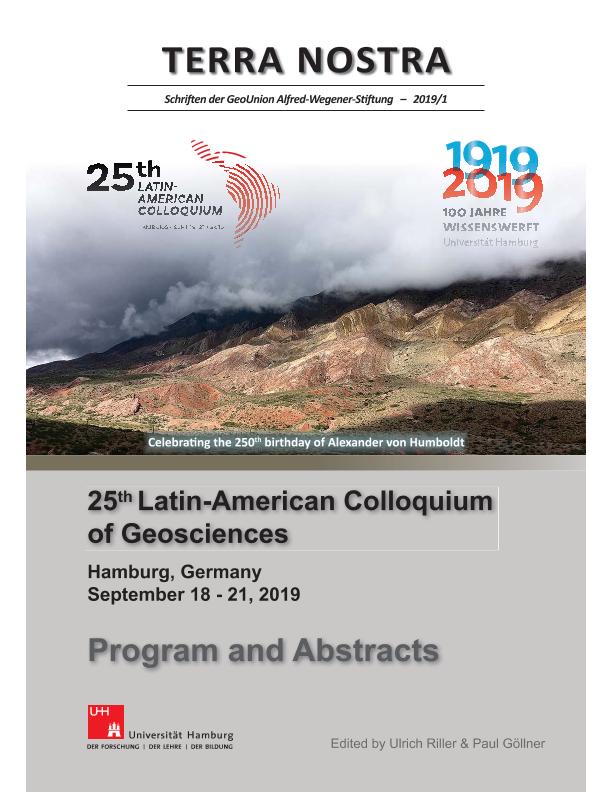Mostrar el registro sencillo del ítem
dc.contributor.author
Angeletti, Melisa

dc.contributor.author
Martinez, Juan Cruz

dc.contributor.author
Frisicale, Maria Cristina

dc.contributor.author
Massonne, H. J.
dc.contributor.other
Riller, Ulrich

dc.contributor.other
Göllner, Paul
dc.date.available
2022-10-24T12:21:10Z
dc.date.issued
2019
dc.identifier.citation
P-T-d path of a garnet-bearing metagranite from the Paleoproterozoic basement of the Tandilia terrane, Rio de la Plata craton, Argentina; 25th Latin-American Colloquium of Geosciences; Hamburgo; Alemania; 2019; 28-29
dc.identifier.issn
0946-8978
dc.identifier.uri
http://hdl.handle.net/11336/174495
dc.description.abstract
The Tandilia Terrane (TT), in central-eastern Argentina and southeastern Uruguay (Pamoukaghlian et al., 2017), is a Paleoproterozoicigneous-metamorphic complex that represents the southernmost expositions of theRio de la Plata craton (RPC). The study area includes the small outcrops of theLa Virgen hill, western TT, mainly composed of a garnet-bearing granite. As wewant to constraint the P-T-d evolution path of this granite, the appraisal ofmicrostructures was integrated to a P-T pseudosection modeled with the PERPLE_Xsoftware for a selected bulk-rock composition in the 11-component systemSi-Ti-Al-Fe-Mn-Mg-Ca-Na-K-O-H, and to various contoured chemical parameters ofinterest. The analyzed rock is a slightly deformed, peraluminous (ASI= 1.07),grey granite composed of (~ vol.%): K-feldspar (37), quartz (30), plagioclase(18), biotite (7), garnet (5), muscovite (2), zircon, apatite, monazite andopaque minerals as accessory phases (1). The porphyroclastic texture, withdevelopment of core-and-mantle, is characterized by a 15 vol.% of fine-grained granoblastic matrix. The derived P-T path is as follows: the garnet corecomposition of pyr4(gro+andr)12spes10alm74,equilibrated with andesine (XAn = 0.37), yielded P-T conditions of 6 kbar and 650°C (Fig. 1, point A) near the melt out curve (~7 vol.% of melt).The stable mineral assemblage at these conditions is Ms+Pl+Kfs+Ilm+Üsp+Grt+Bt+Qtz, as in the natural rock. Garnet recorded a rimward decreased in pyrope from 4 to 3 mol% by slow cation diffusion until its out stability limit is reached at 5.5 kbar and 620°C (Fig. 1, point B). The subsequent path is fairly constrained between isopleths of 3.09-3.17 Si (pfu)in muscovite and XAn = 0.36 in plagioclase. The deciphered evolution path in the studied rock demonstrates the cooling down of a near solidus granitic material during exhumation from the middle crust (22 km), under an apparent geotherm of ~ 30 °Ckm-1, until upper crustal conditions of ~7 km. The ductile microstructures of deformation in the protomylonitic granite are consistent with others microstructures observed in feldspars (deformation twins, myrmekites and flame perthites) which for the 1.5 km distant granitic rock of the Siempre Amigos area were restricted between 650 °C and 430 °C (Angeletti et al., 2016). The exhumation path suggested for the studied peraluminous granite is similar to the garnet-bearing leucogranite of San Veran hill, sited 100 km to the SE of the study area, which was related to a postcollisional stage of the Trans-Amazonian orogeny cycle (Martínez et al. 2017).
dc.format
application/pdf
dc.language.iso
eng
dc.publisher
GeoUnion Alfred-Wegener-Stiftung
dc.rights
info:eu-repo/semantics/openAccess
dc.rights.uri
https://creativecommons.org/licenses/by/2.5/ar/
dc.subject
GEOTERMOBAROMETRÍA
dc.subject
PETROLOGÍA
dc.subject
CRATON RÍO DE LA PLATA
dc.subject
EVOLUCIÓN GEOLÓGICA
dc.subject.classification
Geología

dc.subject.classification
Ciencias de la Tierra y relacionadas con el Medio Ambiente

dc.subject.classification
CIENCIAS NATURALES Y EXACTAS

dc.title
P-T-d path of a garnet-bearing metagranite from the Paleoproterozoic basement of the Tandilia terrane, Rio de la Plata craton, Argentina
dc.type
info:eu-repo/semantics/publishedVersion
dc.type
info:eu-repo/semantics/conferenceObject
dc.type
info:ar-repo/semantics/documento de conferencia
dc.date.updated
2022-03-16T21:03:58Z
dc.journal.pagination
28-29
dc.journal.pais
Alemania

dc.journal.ciudad
Postdam
dc.description.fil
Fil: Angeletti, Melisa. Universidad Nacional del Sur. Departamento de Geología; Argentina. Consejo Nacional de Investigaciones Científicas y Técnicas; Argentina
dc.description.fil
Fil: Martinez, Juan Cruz. Consejo Nacional de Investigaciones Científicas y Técnicas. Centro Científico Tecnológico Conicet - Bahía Blanca. Instituto Geológico del Sur. Universidad Nacional del Sur. Departamento de Geología. Instituto Geológico del Sur; Argentina
dc.description.fil
Fil: Frisicale, Maria Cristina. Consejo Nacional de Investigaciones Científicas y Técnicas. Centro Científico Tecnológico Conicet - Bahía Blanca. Instituto Geológico del Sur. Universidad Nacional del Sur. Departamento de Geología. Instituto Geológico del Sur; Argentina
dc.description.fil
Fil: Massonne, H. J.. Universität Stuttgart. Fakultät Chemie; Alemania. China University of Geosciences. School of Earth Sciences; China
dc.relation.alternativeid
info:eu-repo/semantics/altIdentifier/url/http://www.geo-union.de/terra-nostra.html
dc.relation.alternativeid
info:eu-repo/semantics/altIdentifier/url/https://e-docs.geo-leo.de/handle/11858/7935
dc.relation.alternativeid
info:eu-repo/semantics/altIdentifier/doi/https://doi.org/10.23689/fidgeo-3609
dc.conicet.rol
Autor

dc.conicet.rol
Autor

dc.conicet.rol
Autor

dc.conicet.rol
Autor

dc.coverage
Internacional
dc.type.subtype
Otro
dc.description.nombreEvento
25th Latin-American Colloquium of Geosciences
dc.date.evento
2019-09-18
dc.description.ciudadEvento
Hamburgo
dc.description.paisEvento
Alemania

dc.type.publicacion
Journal
dc.description.institucionOrganizadora
Universität Hamburg
dc.source.revista
Terra Nostra
dc.date.eventoHasta
2019-09-21
dc.type
Otro
Archivos asociados
